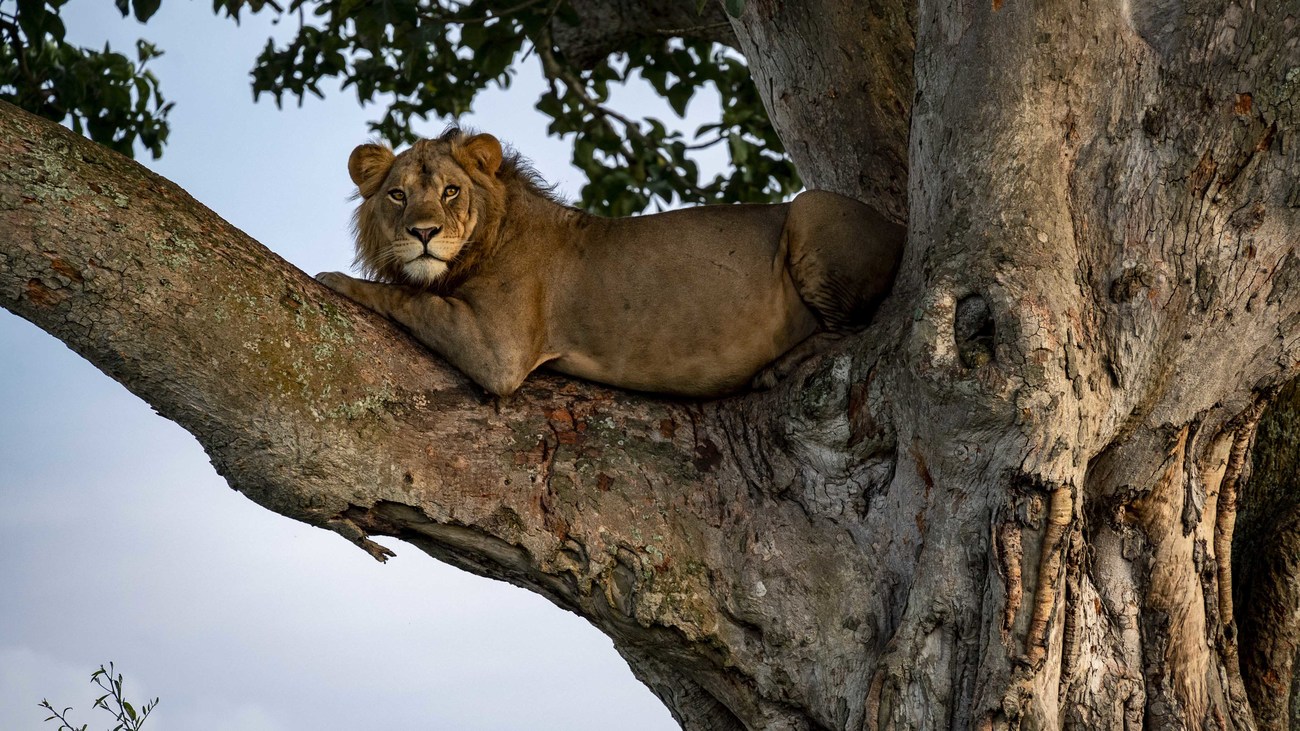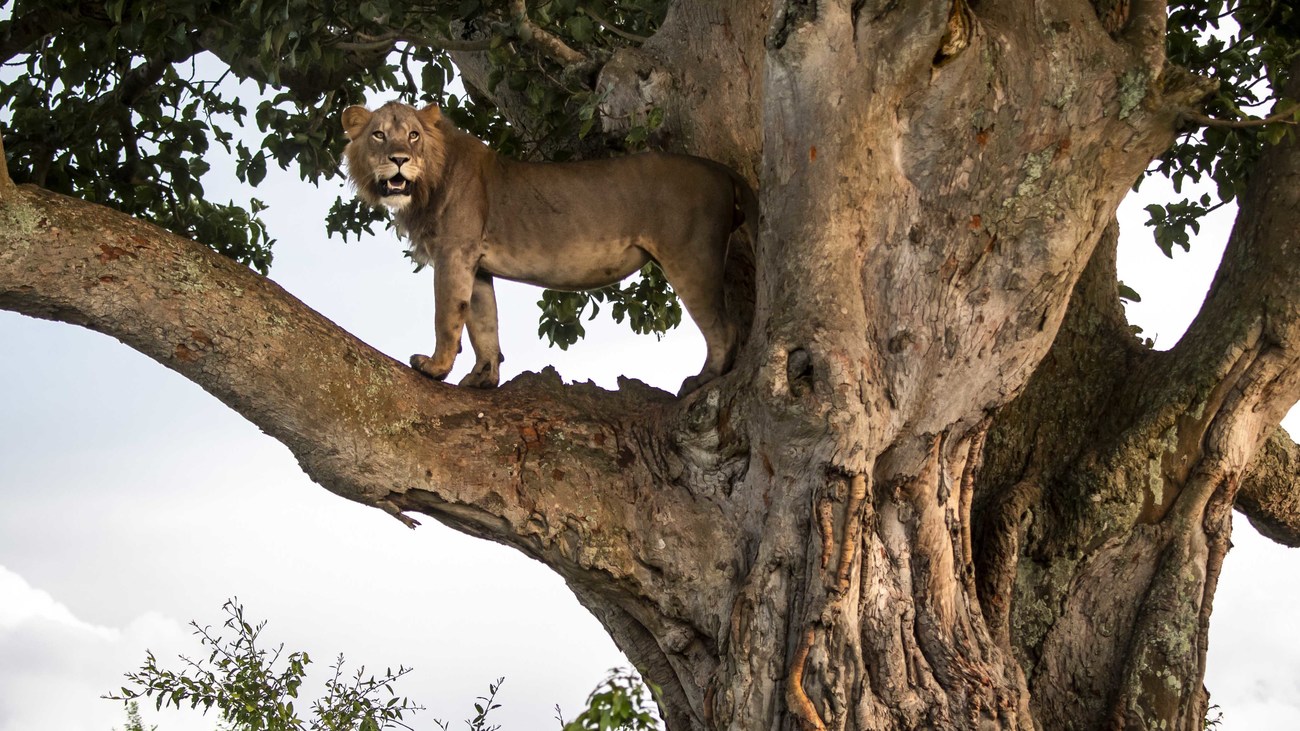Blog
Discover the four layers of the forest—and the animals living in it
Read moresaving the tree-climbing lions of Queen Elizabeth National Park
With the sun still well below the horizon, the savannah is nothing but darkness and shadows. Impatience no longer allows me to wait and I start the off-road vehicle. With headlights that poorly illuminate the path to follow, I begin the search for one of the world’s most marveled groups of animals: Uganda’s tree-climbing lions.
After a few kilometers the sky brightens, allowing me to distinguish the great African figs silhouetted against the weak light of dawn. These are the big trees that can help me find what I am looking for. I feel excitement growing in me despite the awareness of the scarce chance of my mission being successful.
Suddenly two large shadows move in the tall grass. My pulse quickens. I hold my breath, highly aware of my surroundings as time seemingly stops. In one swift motion, the shadows emerge into the light. It’s the legendary "climbing lions of Ishasha,” the very ones I was looking for but doubted to find!

They are two large males, not at all intimidated by the presence of the off-road vehicle. They proceed decisively towards their destination a few hundred meters away, a gigantic African fig tree.
I position the vehicle at the base of the large tree, in the most favorable position to safely view the action that makes these lions unique and famous all over the world.
After a few minutes the two large lions reach the base of the large trunk, and without hesitation, one after the other, they climb up to the first fork of the tree. The lions nimbly settle down at the end of the sturdy branch that will probably house them for the rest of the day—an amazing performance for this kind of heavy feline. An adult male lion can weigh as much as 230 kgs.

Lions in the rest of Africa are generally able to climb, but they do it in an awkward way, and only in cases of special needs. Those of the Ishasha sector of Queen Elizabeth National Park in Uganda—which locals refer to simply as “Queen”—learn to do it from an early age, following their parents in daily acrobatics and soon becoming excellent climbers. But why are they doing it here and not in other parts of Africa? Probably due to the simultaneous combination of three environmental factors: the hot humid climate (which can be alleviated by the elevated position granted by the branches of a tree), distance from annoying tsetse flies on the ground, and finally, the large African fig trees which are relatively easy to climb and give an aerial view of potential prey below, like grazing antelope.
A rare sight that can only be seen here. A show to be studied and protected because of its uniqueness—the Ishasha lion population is no bigger than 35 individuals and unfortunately at risk like all unique and rare things.
In fact, the thin strip of the territory of Ishasha, where this very particular population of lions lives, is bordered to the west by the Democratic Republic of Congo (DRC), while to the east, lays territory mostly dedicated to sheep and cattle farming. Rampant poaching and illegal wildlife trafficking between Uganda and the DRC significantly threaten the biodiversity of the western Great Rift Valley, in particular Virunga National Park in the DRC and Queen in Uganda. On top of this, lions also face the threats of human-wildlife conflict and retaliatory snaring and poisoning.
Funding for this initiative is provided by the U.S. Government through a grant from the U.S. Department of State’s Bureau of International Narcotics and Law Enforcement Affairs (INL), and is supported in its implementation by IFAW. IFAW collaborates with the International Union for the Conservation of Nature National Committee of the Netherlands (IUCN NL) and has partnered with the Ugandan Wildlife Authority (UWA) and the Congolese Institute for the Conservation of Nature (ICCN) to combat cross-border wildlife trade between the two countries. This consortium works with local community members to tackle and prevent wildlife crime. It also supports rangers with the skills and tools needed to protect endangered wildlife like the Ishasha lions, pangolins and elephants.
During my visit to Queen, I have the opportunity to meet the ranger teams that protect the park's lions and patrol the bush in search of poachers. I join one of the heavily-armed ranger teams on one of these missions. We follow small paths traced by gazelles, buffaloes and hippos among thorns, brambles and muddy marshes. The rangers proceed in silence, guided by experience and a strong sense of direction. They move fan-shaped, often out of sight of one another but in constant contact thanks to short, subdued conventional whistles. They check the paths, the base of the bushes and the watering points, looking for even the most insignificant trace—and in the end, they discover the first snare.
I can't locate it even when the lead ranger patiently points it out to me with his finger. The only trace is a small piece of wood planted deep in the mud. He cautiously removes it and reveals the invisible steel cable with its noose that would inexorably capture any animal that was trapped there.

Having neutralized the first snare, the rangers begin the search for others. In fact, they explain to me that poachers always place four or five in the same area, to facilitate their recovery. It takes no time to find two other poachers’ snares similar to the first, and two others that are much more robust and heavy, probably destined for buffalo and hippos. All this in fewer than three hours of patrol.
After this mission we return to the camp, where they show me the container for all the traps recovered in the bush. The heavy door opens to reveal an unimaginable number of laces, steel cables, nets, spears and snares of all kinds and shapes, including heavy snap traps. An amazing arsenal they’ve collected over the last five years.
The rangers’ work often seems endless: one day the poachers set the traps, and the next day rangers remove them, repeating the actions day after day. Despite these challenges, they remain determined to build a better future for Uganda’s wildlife.
I am moved by the simple comment of one ranger who, smiling, says to me: "Well, even today, five fewer dead animals.”
-Paolo Torchio
www.paolotorchio.net
FB: @PaoloTorchioWildlifePhotography
IG: @p.torchio.images_from_the_wild
This article was funded, in part, by a grant from the United States Department of State. The opinions, findings and conclusions stated herein are those of the author and do not necessarily reflect those of the United States Department of State.

Every problem has a solution, every solution needs support.
The problems we face are urgent, complicated, and resistant to change. Real solutions demand creativity, hard work and involvement from people like you.
Unfortunately, the browser you use is outdated and does not allow you to display the site correctly. Please install any of the modern browsers, for example:
Google Chrome Firefox Safari